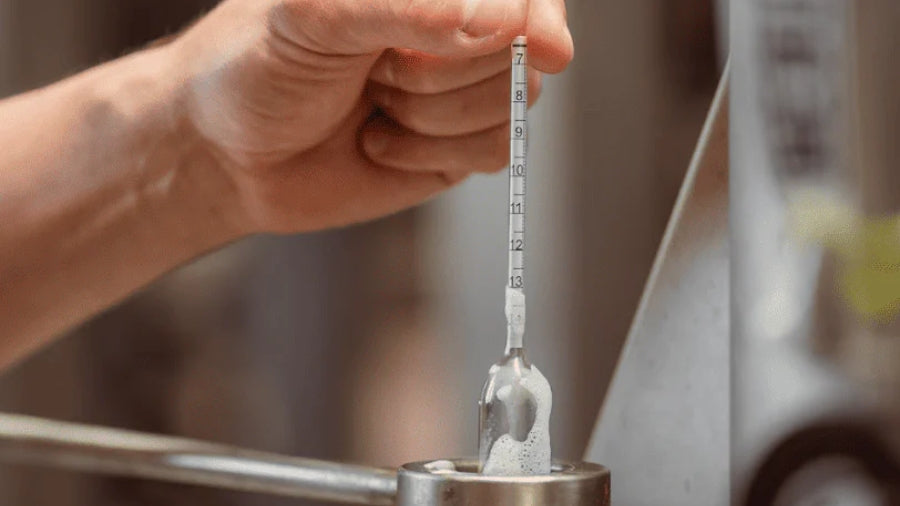Water in brewing: the secret ingredient of an exceptional beer

Water, the diva of brewing, makes up over 90% of your beer. Yet it often remains in the shadows. other fundamental ingredients : hops and malt. One ingredient among others ? Not really. Its mineral composition and pH play a crucial role in creating an exceptional beer. Much like a discreet but indispensable conductor, water directs the symphony of flavors that plays out in your glass. This mastery of water is one of the secrets that transforms a decent beer into a memorable creation.
The Science of Water in Craft Brewing
The secrets of minerality in the character of a beer
Think of water as a mineral paint palette. Each ion contributes its own touch to the final painting, in a complex choreography that influences every stage of the brew. Calcium , the true hero of mashing, doesn't just boost enzyme efficiency like a fitness coach for your starches. It also naturally lowers pH, facilitates protein flocculation during boiling, and even helps our yeast friends acclimate during fermentation. Not bad for a single mineral, eh?
Sulfates, on the other hand, are the rock stars of bitterness. They enhance the bitter compounds in hops and accentuate their characteristic dryness, creating that clean, crisp finish we love in well-hopped IPAs. Conversely, chlorides play the balancing act, smoothing out the rough edges for a silky mouthfeel and highlighting the malt's complexity. This subtle science helps differentiate a craft beer from its industrial cousin .
Magnesium, on the other hand, is the Swiss Army knife of brewing: it helps enzymes during mashing, feeds yeast during fermentation, and contributes to mouthfeel. But be careful not to overdo it, because above 30 mg/L, it can impart a harsh bitterness that would make even the most hardened hoppy beer lover cringe.
A subtle balance to reveal the flavors
Zepp , our dry, floral craft lager , perfectly illustrates this alchemy of water. Its crystal-clear profile and clean finish are the result of a meticulously crafted water profile, where each mineral plays its part. A carefully calibrated sulfate-to-chloride ratio, combined with an optimal calcium level, achieves this characteristic clarity while preserving the delicate floral notes that are its signature.
This control of minerality also influences the stability of the foam, the clarity and even the conservation of the beer. Sodium , for example, in low doses (less than 150mg/L) contributes to the roundness in the mouth. Beyond that, it can quickly transform your beer into an experience worthy of a vegetable broth - not really the desired effect!
Water, architect of beer styles
From Soft Water to Hard Water: Shaping Character
It's not just the creativity of brewers that has led to beers developing such diverse characters across Europe—though we love to take all the credit for that. The natural composition of local water has historically dictated beer styles, creating a fascinating diversity of regional profiles. The soft waters of Pilsen, with less than 10 mg/L of calcium, gave rise to light, refined lagers. Meanwhile, the hard waters of Burton-on-Trent, rich in sulfates (up to 800 mg/L) and calcium, sculpted the crisp, dry character of English ales. A natural evolution that has shaped the classics of the brewing world .
This water geography explains why Munich's brewers, with their carbonate-rich water, naturally gravitated toward darker malts: the alkalinity of their water matched perfectly with the acidity of these malts. It's as if the local water had subtly guided the brewers' hand through the centuries.
pH, the key to brewing excellence
pH, that small number that hides a world of complexity, is the metronome of brewing. Its influence extends far beyond simple acidity. In mashing, an optimal pH between 5.2 and 5.6 is crucial for the activity of enzymes that convert starch into fermentable sugars. Too high, and tannin extraction accelerates, creating a harsh bitterness. Too low, and starch conversion slows, impacting brewing efficiency.
Moonshine , our cloudy and fresh white beer , is a true demonstration of this mastery of pH. Its characteristic freshness is based on a specific water profile, with a negative residual alkalinity that perfectly matches the high proportion of wheat malt. This precision allows the yeasts to express their citrus and spice notes accurately, without astringency interfering with the picture.
Adjusting pH is a delicate art that plays out throughout the entire process. During boiling, it influences the isomerization of hop alpha acids. During fermentation, it impacts yeast health and therefore aroma production. Even beer clarification and stability depend on this crucial parameter.
Water in breweries: between tradition and scientific precision
Water in a brewery is ultimately like the bass in a rock band: you don't always notice it, but try to play without it and everything falls apart. Mastering this fundamental ingredient is the hallmark of brewers who leave nothing to chance in their quest for excellence.
Today, modern technologies allow us to precisely adjust the composition of our water, freeing brewers' creativity from the geographical constraints of yesteryear. But true expertise lies in the in-depth understanding of its impact on the final character of the beer. It is this subtle blend of science and craftsmanship that creates unique beers, where each sip tells a story of precision and passion.









